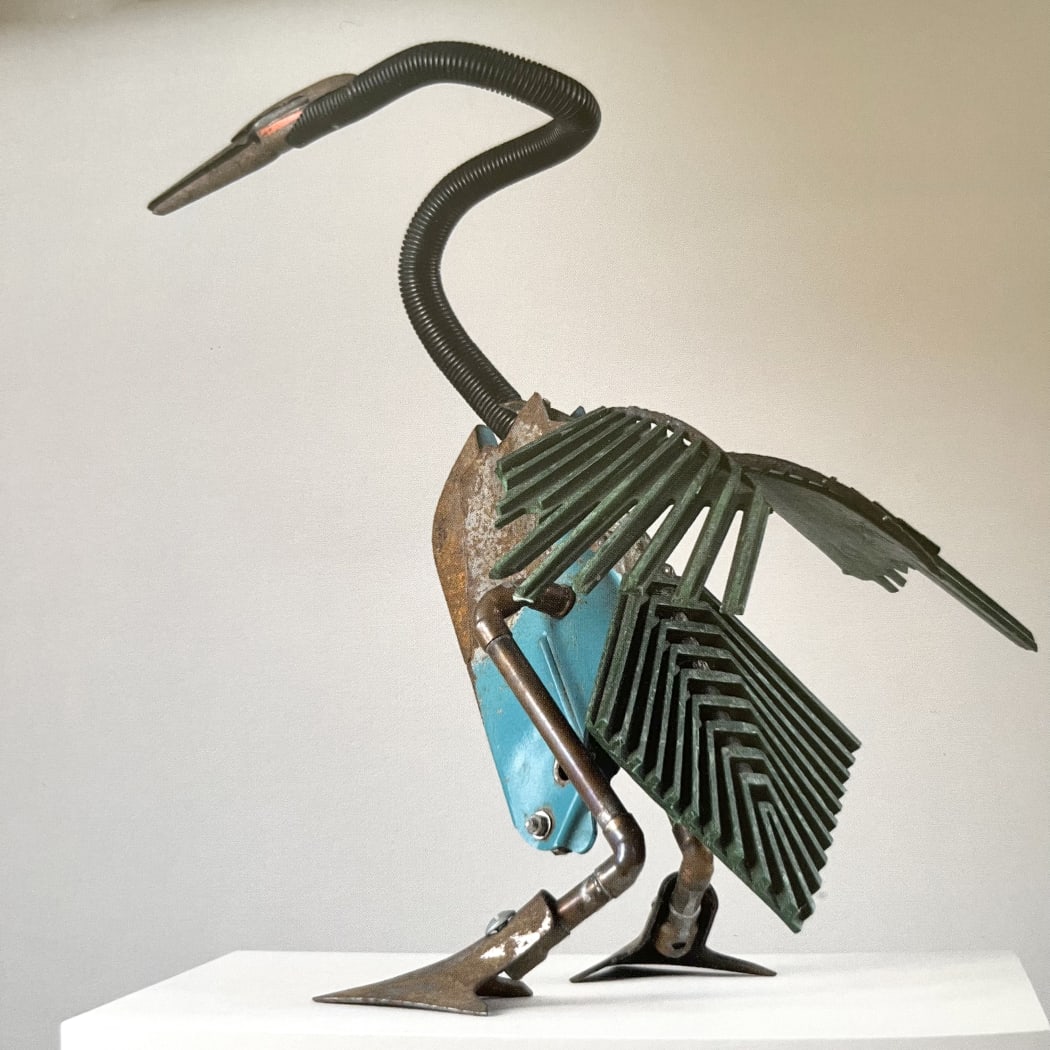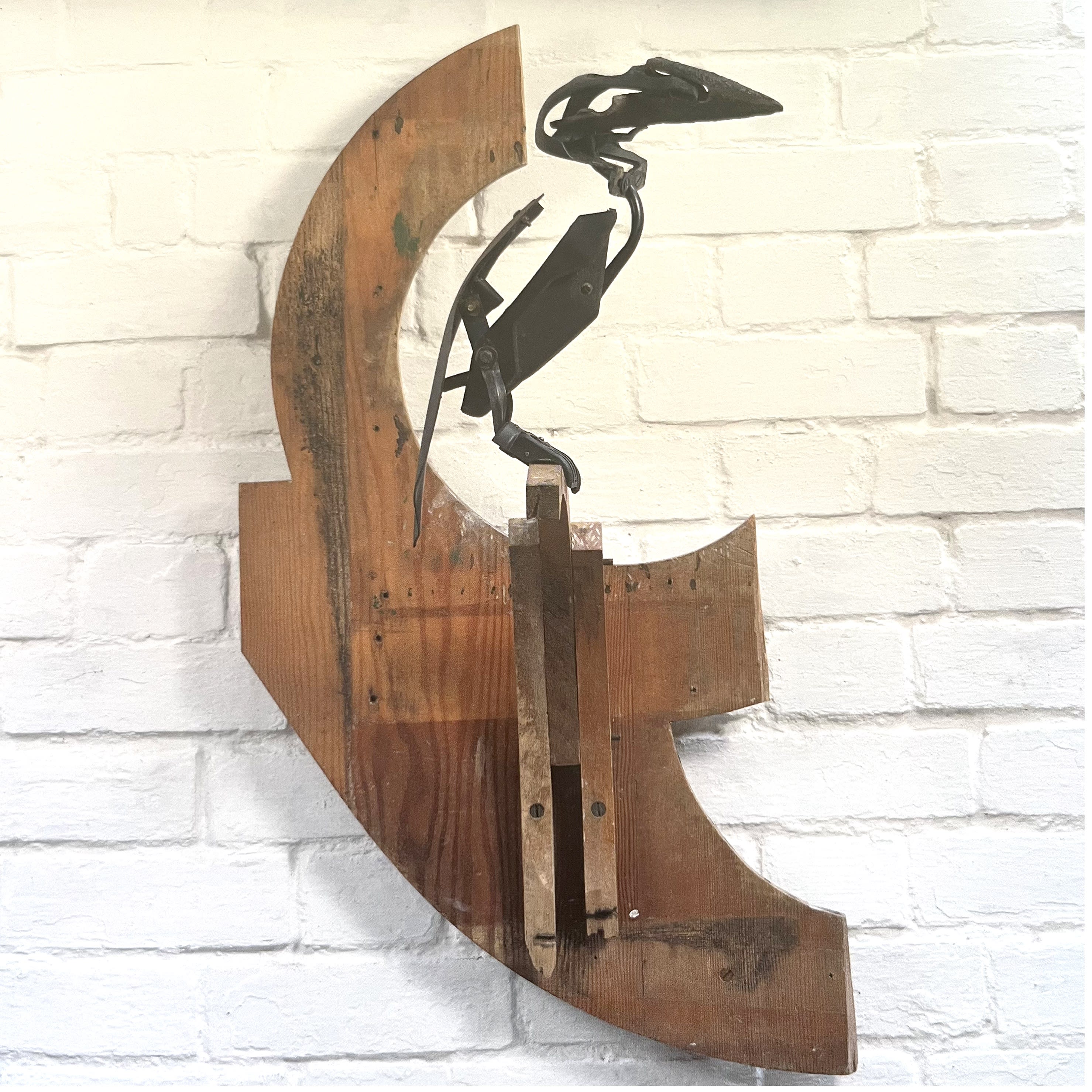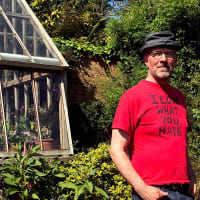
Eel Catcher (2004/7) 50.5 x 47 x 40 cm Steel, plastic, copper.
What you see here in River's Edge only hints at the depth of knowledge of animal anatomy she accumulated during a productive lifetime, and is not entirely representative of her oeuvre. We could not accommodate her groundbreaking taxidermy installations within the scope of this exhibition, however, we hope this small collection of bird sculptures will prove a timely tribute - and a reminder of how inspiring, innovative and influential Emily Mayer was in everything she did.

Plas - tic - tockus (2005/7) 79 x 44 x 41.5 cm wood, plastic, steel.
'Out of Context' was a solo exhibition of Emily Mayer's work at the Campden Gallery, London 2007. The exhibition encompassed many of the bird sculptures as well as her taxidermy work that Emily pioneered years before Damien Hirst and others included this fusty and macabre Victorian pastime and made it part of their sculptural language.
In a 1995 catalogue accompanying her solo exhibition 'Material Evidence' at Triskel Arts Centre, Cork, Ireland, Emily describes her creative process in her own terms.
"It is the animal which originally informed my ideas for sculpture but it is the materials themselves which manifest those ideas. Now I no longer know which arrives first: an idea for a sculpture from the animal or an idea about the animal through the materials I'm using. I suspect that it is a continuing dialogue between myself, the animal, the material and the making of the sculpture."
There is an excellent catalogue essay by Rachel Campbell-Johnston, Art Critic at The Times, that accompanied the exhibition, a passage from which we have reproduced below, covering a little about Emily Mayer's fascination with living creatures, her interest in transforming found-objects into animals and how taxidermy can be used to extend their life... even after it has been extinguished.

Jesus Bird (2004/7) 50.5 x 51 x 50 cm Steel with paint, aluminium
"It is the attentiveness of the naturalist as much as the technique of the craftsman that she brings to her work. Mayer has loved wildlife ever since she was a child when, crouched in the rain, she would stroke slippery slugs, or bent over the kitchen table, draw dead field mice. And she has far too much respect for living creatures to take liberties with their corpses. She has no desire to adapt their wild natures to an anthropomorphic harness.
It is this search for something more than mere replication that hs provoked Mayer to return again and again to her found-object sculpture. Some of these pieces take years to assemble. From the disparate heaps of driftwood, scrap-metal, bits of leather, dismembered farm implements, machine parts and broken domestic objects that lie about in her studio she painstakingly fits together parts to evoke the essence of a creature: the scoops and spades and spatulas of bones, the rope-over sinews; the muscles that ratchet and slack.
When the sculpture is finished, the animal cannot necessarily be precisely identified. That bird with the burnt-out tyre for back, for instance: it's not a bittern or a merganser or a penguin or cormorant. And yet you will recognise the dark oily hunch of the water bird as surely as you would recognise the real creature, spotted for a few seconds among marshy reeds. Mayer's sculptures are not about the outside. They evoke the inner spirit of the animal.
But can this ever be captured? Mayer asks herself that question. In 'The Critics' she recreates, using taxidermy, a pair of brown rats. She sends them on an impudent investigation of a found-object sculpture. Mayer turns her ironic gaze upon her own pieces. But she offers no straightforward answers."
About the author

Paul Barratt
Paul Barratt started working in contemporary art galleries in 1989, having graduated in Fine Art from Goldmsith’s, London University. He initially worked at Anthony d’Offay Gallery, one of the contemporary art dealers, who dominated the London art market in the 80s and 90s. He was approached by the Lisson Gallery to be gallery manager for the influential art dealer Nicholas Logsdail. This was followed by a short period in New York at Gladstone Gallery, to work for visionary art dealer Barbara Gladstone, working with the artist and filmmaker Matthew Barney.
On his return to London, Paul secured a place on the postgraduate curatorial course at the Royal College of Art, to complete an MA. After graduation in 2001, he worked as an independent curator on several projects in Oslo, London, Brighton and Basel, before joining Paul Vater at his design agency Sugarfree in 2004. He has worked with Paul ever since.



